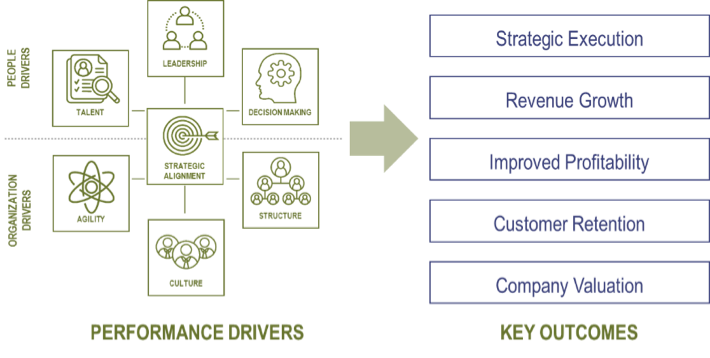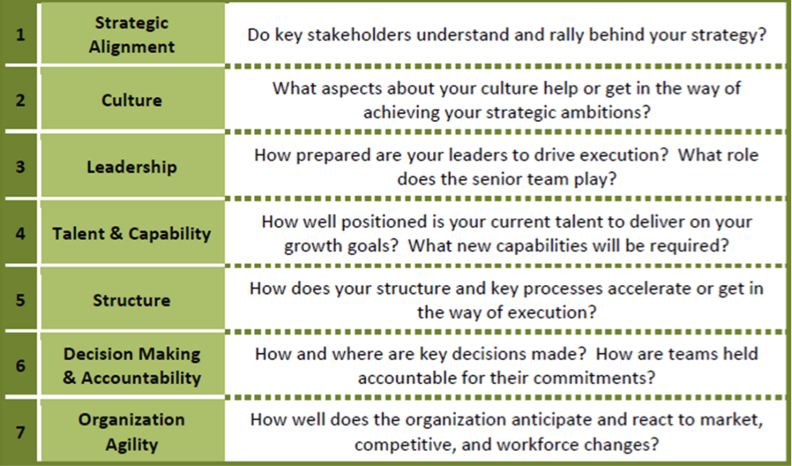Essential Organization Performance Drivers to Deliver Business Growth
Driving sustainable business growth is no easy task. As organizations become increasingly complex, global, and boundaryless, CEOs are hungry to find a new way to uncover performance improvement opportunities across their businesses. Senior leaders need to balance the ability to move quickly with the need to develop internal capabilities to ensure efficient and long-term success. Leaders can be quickly overwhelmed by the volume and velocity of new–and untested–business ideas coming at them. We believe that the greater opportunity is to provide focus rather than add to the noise.
Based on our collective experience, numerous organization assessments, client feedback, and an exhaustive review of organization science research, we see seven performance drivers that stand out as having the greatest impact on organization performance and growth. As depicted below, the PD7 (short for 7 Performance Drivers) Organization Performance Model outlines these drivers and shows their relationship to one another. Three of these drivers represent “people” factors; another three represent “organization” factors, and one sits at the center, connecting the other six.
While these factors can apply to companies at almost any size, we find them to be most relevant to middle market/mid-cap businesses. Specifically, these drivers reflect the unique growing pains that these rapidly growing business CEOs and their teams must navigate. Whether it’s a significant change in strategy, a new major investor, or one company acquiring another to accelerate growth, assessing organization strengths and gaps on these seven performance drivers provides fresh insight and equips leadership to take quick action to drive performance.
The PD7 Organization Performance Drivers & Outcomes

Strategic Alignment. Strategy serves as the foundation for the other six drivers. To understand how each of the other performance drivers contributes to success, CEOs must first understand their organization’s strategic context. Developing a robust, well-defined strategy is just the first step. Effectively communicating that strategy and ensuring a strong connection between employees’ everyday efforts and broader strategic priorities gives it life. Strategic alignment represents one of biggest organization blind spots we come across. Often, what executives believe is crystal clear in their own minds becomes more vague, inconsistent, and short-sighted the further away from the executive suite one sits. Alignment is the first key step toward successful strategy execution.
Leadership. While strategy creates an important context, effective leadership plays an essential role in ensuring alignment. We find that given the middle market’s maniacal focus on growth, leadership scalability represents the most critical leadership attribute at this stage of growth. Can those in key leadership positions take on increasingly more complexity and responsibility and demonstrate greater indirect influence as the business grows? Additionally, to deliver sustainable growth, the individual impact of a CEO’s leadership is no longer enough to deliver it long term. Leadership as a capability must be institutionalized, with clearly defined expectations for leaders at all levels. The combined impact of the CEO’s direct reports, based in large part on how they operate as an effective leadership team, plays a key role in modeling required leadership behaviors throughout the organization. These dimensions of leadership are often undervalued and underinvested in by companies at this stage of growth.
Organizational Culture. When cultivated effectively, culture represents one of the greatest intangibles a company can have. Yet, for many high-growth companies, culture is something that just “happened.” Culture is the outcome of leadership actions — there is no bigger influence on culture than what leaders prioritize, model, and reinforce. To scale, leaders must invest time and attention around proactively shaping culture and rewarding the behaviors and mindsets required to achieve longer-term strategic goals. Culture either works for you or against you—it’s never neutral. Shaping culture can be deliberate and managed with proper leadership focus.
Talent & Capability. The war for talent has never been more acute, particularly for mid-market companies looking to differentiate themselves as an employer of choice. Bringing in new capabilities through external hiring predictably takes longer than expected, and quietly contributes to stalled growth before more visible burning platforms emerge. It’s critical that leaders have a clear understanding of the organization’s current human capital and how it maps to future needs based on strategic priorities.
Structure. Organization structure facilitates effective accountability, communication, and timely decision-making. At this stage of growth, many mid-cap companies realize that their original organization structures are no longer sufficient to scale their business to the next level. They struggle to balance wanting to retain a flat structure with single leaders taking on responsibilities across multiple areas with the need for greater specialization to improve focus and depth. For this reason, structure is usually the first of the seven performance drivers that executives alter to create change. However, while structural change is tangible and actionable, it can also be highly disruptive and is usually minimally effective by itself. It’s been likened to using a hammer to perform brain surgery, and as one executive we’ve previously worked with said, “you can’t restructure your way out of problems you behaved your way into.” Of all the drivers discussed, structure must be examined in context of the other drivers, never in insolation. Specifically, leaders must evaluate how newly proposed structures accelerate decision making, increase organization agility, shape culture, and/or align the organization around key strategic priorities.
Decision Making & Accountability. A key refrain from many of our high growth clients is that decision making remains heavily concentrated at the top, creating an execution bottleneck while simultaneously disempowering the next layer down. A major inflection point between smaller, more entrepreneurial companies and larger, more complex ones is that the latter has figured out how to scale decision-making capabilities. Clarity around what decisions get made where and by whom, and ensuring accountability for executing those decisions, goes a long way to unlocking organizational speed. It also minimizes the need to constantly re-evaluate structural changes, as described earlier. Our experience is that decision making needs to take place where the work really happens and closest to the customer. Accountability cannot be cascaded until decisions are shared.
Agility. Mid-market companies often suffer the Goldilocks Dilemma. They are too big to still be making up processes as they go, and too small for over-engineered global operating models. Confidence gained in early rounds of success can isolate leaders from uncovering emerging customer preferences, which creates an increasingly insular focus. Resilient mid-market companies maintain a strong pulse on their customer, reacting to – or better yet – proactively adjusting course to seen and unforeseen market shifts. Leaders must convey an external, market-focused mindset externally while nurturing a culture of learning and experimentation internally.
In Summary
Collectively, these seven performance drivers can have a significant impact on an organization’s peak performance. Over the next several months in this blog, we will be exploring each of these seven performance drivers in more detail—why they are important, how to assess them and ways to make them stronger assets in your organization. We look forward to continuing the conversation.
If you’re wondering where your organization stacks up, we’ve provided questions below for self-assessment. Answer honestly, and then ask your team to do the same. Where you agree? Where you see things differently?
Key Questions to Help Assess the Seven Performance Drivers

Summit Leadership Partners advises Boards, Investors, CEOs, and senior leaders on strategically scaling business through talent and organization assessment, executive team performance and coaching, leadership development, and organization effectiveness. Our consulting team has held top leadership roles in successful companies across the globe. We are seasoned experts in strategy, assessment, leadership development, coaching, strategic talent management, and organization development. Connect with us to learn more about how we can help your business.
This post contributed by Todd Fryling.